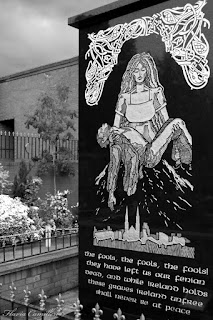Well, of course, I could not offer only
bread to my friends, so here comes the rest..
The two recipes are both based on potatoes, which is one of the main elements of the Irish cuisine.
Leeks and potato soup
First note, I think that I had never consciously eaten leeks, and I have to admit that I like them a lot..as sweeter than onions (and I think also more digestible).
What you need is:
-
500 gr of leeks, cut in small slices avoiding to take also the green part which has a much stronger taste
-
200 gr of onion, cut in small slices
-
50 gr of butter
-
3 litres of vegetable stock
-
500 gr of potatoes, cut in small cubes
- herbs (I have used only
parsley, but the recipe suggests also basil, thyme, laurel).
In a big casserole, let the onions and the leeks sauté (
why the English does not have proper terms when comes to cooking and they have to take French words? ;( ) with the butter. I waited until the onions and leeks were really well cooked as I do not like the taste that they have when they are raw, so in my mind ;) this would have decreased it...but well, I am not a chef ..;)
Add the stock and the herbs and wait until it boils.
Skim it (
and it is still a mystery how to do this! ;)), add the potatoes and cook slowly,...
until the ingredients are melted as in a cream....this last part is what the recipe says, I would tell you to cook for one hour more or less.....
Now the recipe (which comes from the same source as that of the
soda bread and of the next recipe) does not suggest to whip the ingredients, but I did as I preferred a more creamy soup.
On the contrary, the recipes suggests that, if wanted, liquid cream or béchamel can be added....I didn't....ehm, am I becoming too much rebel? ;)..
The result was perfect and my friends liked it a lot! :)
 |
| Leek and potato soup on the plate (photos taken with the compact camera) |
More recipes (in Italian) here:
http://www.cookaround.com/ricetta/crema-di-porri-e-patate.html
http://blog.giallozafferano.it/thebigdreamfactory/zuppa-di-porri-e-patate/#
Irish stew
(Irish:
stobhach /
Stobhach Gaelach)
Here another rebellion ;): the Irish stew is commonly prepared with mutton or lamb: for the first I have no idea where to find it and if I like the taste....for the second...well, I know that this is a kind a racism over animal species (I mean, why the pork or the beef yes and the lamb no?)...but I do feel more guilty eating these animals, as well horses or birds...Of course, I do feel guilty eating also all the rest, but the 7-year of vegetarianism taught me that my body needs the meat...and then this is my compromise.
So, I have used beef, feel free to use the meat you prefer! :)...if you use lamb, they suggest the shoulder or the thigh.
Ingredients:
- 2 kg of meat cut in pieces of an average size
- 1.5 kg of potatoes clean and cut in pieces
- 4 onions and 4 leeks
(I have used only onions as my estimation at the supermarket was not really good and the leeks bought were enough only for the soup...moreover, I think I used less than 4 onions)
- 8 carrots
- parsley, salt, pepper if wanted
- 1,7 litres of meat stock.
How to prepare it:
Boil the pieces of meats, drain them and throw away the water (I would say 20-30 mins in total).
In a pan or a casserole, put together the meat, the onions, the carrots, the herbs and the stock.
Cook slowly for one hour.
Add the potatoes and cook for other 40-45 minutes.
The maximum cooking time for Irish stew is 2 hours! ;)
Serve with fresh parsley.

 |
| Irish stew (photos taken with compact camera) |
Another recipe can be found here (in Italian)
http://www.irlandaonline.com/cultura/cucina/ricette/irish-stew-stufato-irlandese/
Some history here:
https://en.wikipedia.org/wiki/Irish_stew
http://homecooking.about.com/od/foodhistory/a/irishstewhistry.htm ...
do not ask me why the stew in the picture in this website is so dark brown...I guess because of the Guinness, which is sometimes added as traditional ingredient...I saw a lot of pub serving Irish stew with Guinness...no, I do not like beer, if wondering ;)...
So if you fancy a
Guinness stew,
here you find the recipe.
According to the author..."
By the time you're done cooking the stew down, the bitterness is largely gone and you're just left with nice flavors of caramel, a little bit of caramel chocolatey with a roast to it."
So it may worth a try! :)
The Dessert
Not Irish, but fantastic as well....yogurt cake and ice-cream!
 |
| Yogurt cake and ice-cream (photo taken with compact camera) |























